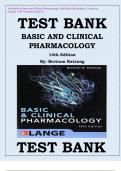Exam (elaborations)
Test Bank for Basic and Clinical Pharmacology 14th Edition By Bertram G. Katzung Chapter 1-66 Complete Guide A+
- Course
- Institution
- Book
TEST BANK BASIC AND CLINICAL PHARMACOLOGY 14th Edition By: Bertram Katzung TEST BANK Test Bank For Basic and Clinical Pharmacology 14th Edition by Bertram Katzung Table of Contents: Section I: Basic principles Chapter 1: Introduction: the nature of drugs & drug development & regulation Chapter 2: D...
[Show more]



